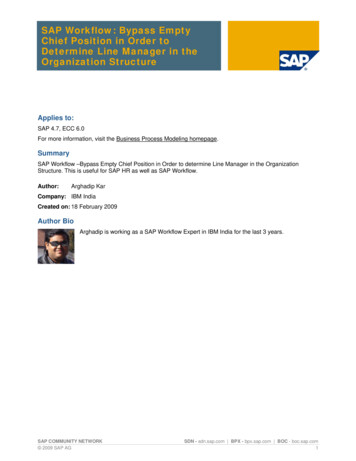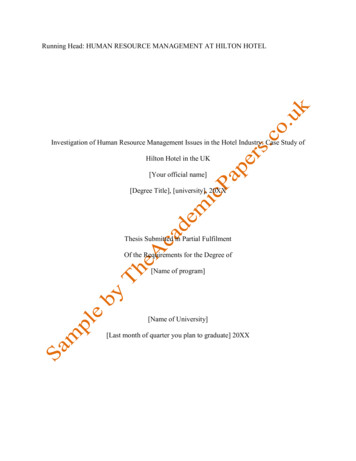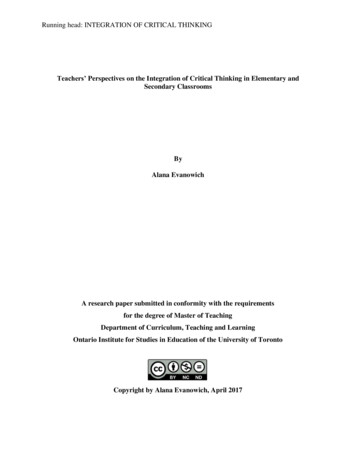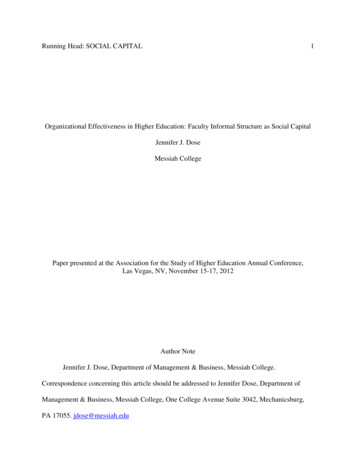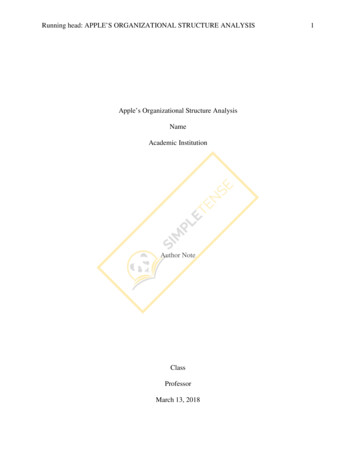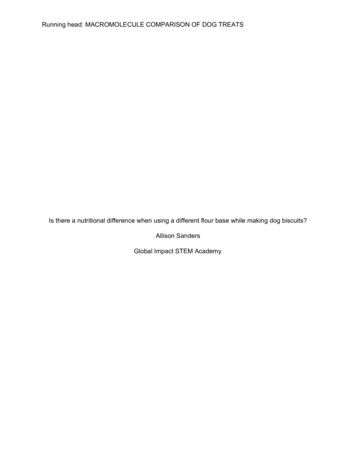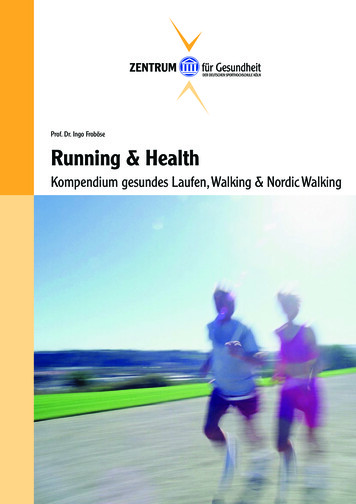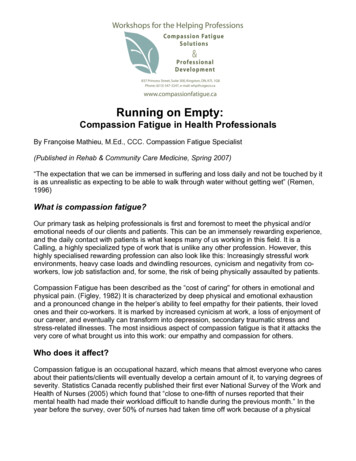
Transcription
Running on Empty:Compassion Fatigue in Health ProfessionalsBy Françoise Mathieu, M.Ed., CCC. Compassion Fatigue Specialist(Published in Rehab & Community Care Medicine, Spring 2007)“The expectation that we can be immersed in suffering and loss daily and not be touched by itis as unrealistic as expecting to be able to walk through water without getting wet” (Remen,1996)What is compassion fatigue?Our primary task as helping professionals is first and foremost to meet the physical and/oremotional needs of our clients and patients. This can be an immensely rewarding experience,and the daily contact with patients is what keeps many of us working in this field. It is aCalling, a highly specialized type of work that is unlike any other profession. However, thishighly specialised rewarding profession can also look like this: Increasingly stressful workenvironments, heavy case loads and dwindling resources, cynicism and negativity from coworkers, low job satisfaction and, for some, the risk of being physically assaulted by patients.Compassion Fatigue has been described as the “cost of caring" for others in emotional andphysical pain. (Figley, 1982) It is characterized by deep physical and emotional exhaustionand a pronounced change in the helper’s ability to feel empathy for their patients, their lovedones and their co-workers. It is marked by increased cynicism at work, a loss of enjoyment ofour career, and eventually can transform into depression, secondary traumatic stress andstress-related illnesses. The most insidious aspect of compassion fatigue is that it attacks thevery core of what brought us into this work: our empathy and compassion for others.Who does it affect?Compassion fatigue is an occupational hazard, which means that almost everyone who caresabout their patients/clients will eventually develop a certain amount of it, to varying degrees ofseverity. Statistics Canada recently published their first ever National Survey of the Work andHealth of Nurses (2005) which found that “close to one-fifth of nurses reported that theirmental health had made their workload difficult to handle during the previous month.” In theyear before the survey, over 50% of nurses had taken time off work because of a physical
illness, and 10% had been away for mental health reasons. Eight out of ten nurses accessedtheir EAP (employee assistance program) which is over twice as high as EAP use by the totalemployed population. In addition, nurses reported on the job violence and were found “morelikely to experience on the job violence than all other professions.” (ONA, 2006) A study ofCancer Care Workers in Ontario carried out in 2000 also found high levels of burnout andstress among oncology workers and discovered that a significant number of them wereconsidering leaving the field: 50% of physicians and 1/3 of other cancer care professionalshad high levels of emotional exhaustion and low levels of personal accomplishment.(Grunfeld 2000) Similar findings have been found among other helping professionals such aschild protection workers, law enforcement, counselors and prison guards. (Figley, 2006)Signs and Symptoms of Compassion FatigueEach individual will have their own warning signs that indicate that they are moving into thedanger zone of compassion fatigue. These will include some of the following: ExhaustionReduced ability to feel sympathy and empathyAnger and irritabilityIncreased use of alcohol and drugsDread of working with certain clients/patientsDiminished sense of enjoyment of careerDisruption to world view, Heightened anxiety or irrational fearsIntrusive imagery or dissociationHypersensitivity or Insensitivity to emotional materialDifficulty separating work life from personal lifeAbsenteeism – missing work, taking many sick daysImpaired ability to make decisions and care for clients/patientsProblems with intimacy and in personal relationshipsDrs Figley and Stamm have developed a Compassion Fatigue self-test called the ProQuolthat can be taken online to assess one’s own level of CF. It is considered the most effectivescreening tool to date: www.isu.edu/ bhstamm/tests.htm. You can also access a very easyself-scoring excel version of it by emailing me at: thingy@aweber.com. I affectionatelyrenamed the ProQuol “thingy” as I found the original name rather unwieldy.Learning to recognise one’s own symptoms of compassion fatigue has a two-fold purpose:firstly, it can serve as an important “check-in” process for a helper who has been feelingunhappy and dissatisfied, but did not have the words to explain what was happening to them,and secondly, it can allow them to develop a warning system for themselves.Say, for example, that a helper was to learn to identify their compassion fatigue symptoms ona scale of 1 to 10 (10 being the worst they have ever felt about their work/compassion and 1being the best they have ever felt) and they learned to identify what an 8 or a 9 looks like forthem (ie: “ when I’m getting up to an 8, I notice it because I don’t return phone calls, thinkRunning on Emptyp.2
about calling in sick a lot and can’t watch any violence on tv” or “I know that I’m movingtowards a 7 when I turn down my best friend’s invitation to go out for dinner because I’m toodrained to talk to someone else, and when I stop exercising.” Being able to recognize thatone’s level of compassion fatigue is creeping up to the red zone is the most effective way toimplement strategies immediately before things get worse.Contributing FactorsAs a Compassion Fatigue Specialist, I offer training, counselling and consultation to helpersacross the country. During these workshops, I have heard the stories of hundreds of resilienttherapists, nurses, midwives, personal support workers, correctional workers, ministers,physicians, psychologists, social workers and students in these professions. What we havediscovered through these conversations is that compassion fatigue exists on a continuum,meaning that at various times in our careers, we may be more immune to its damagingeffects and at other times feel very beaten down by it. Within an agency, there will be, at anyone time, helpers who are feeling well and fulfilled in their work, a majority of people feelingsome symptoms and a few people feeling like there is no other answer available to them butto leave the profession. Many factors contribute to this continuum: personal circumstancesand the helper’s work situation.Current life circumstanceThe helper’s current life circumstance, their history, coping style and personality style allaffect how compassion fatigue works its way through. In addition to working in a challengingprofession, most helpers have other life stressors to deal with. Many are in the “sandwichgeneration” meaning that they take care of both young children and aging parents. Helpersare not immune to pain in their own lives and in fact some studies show that they are morevulnerable to life changes such as divorce and difficulties such as addictions than people whodo less stressful work.Working conditionsHelpers participating in compassion fatigue sessions will often say “I don’t have any problemswith my clients/patients, in fact, I love my client work, it’s everything around it at work that isgrinding me down.” It is clear that clients and their stories are not always the main source ofstress for helpers -it’s also the paperwork, the new computerized time tracking system theyhave to learn, and, let’s not forget, the 10th “restructuring/merging with the agency nextdoor/new executive director/best practice remodel that an agency is going through for the 4thtime in 10 years. Moreover, helpers often do work that other people don’t want to hear about,or spend their time caring for people who are not valued or understood in our society, (forexample, individuals who are homeless, abused, incarcerated or chronically ill). The workingenvironment is often stressful and fraught with workplace negativity as a result of individualcompassion fatigue and unhappiness.What can be done to prevent Compassion Fatigue?Compassion Fatigue is a treatable problem providing we recognise the signs and symptomsearly and that the level of intervention is appropriate to the level of compassion fatigueRunning on Emptyp.3
present in the helper. There are strategies and solutions both at the personal and at theorganizational level.Organizational StrategiesThere are many simple and effective strategies that helpers can implement to protectthemselves from compassion fatigue. First, by openly discussing and recognizingcompassion fatigue in the workplace, helpers can normalise this problem for one another.They can also work towards developing a supportive work environment that will encourageproper debriefing, regular breaks, mental health days, peer support, assessing and changingworkloads, improved access to further professional development and regular check-in timeswhere staff can safely discuss the impact of the work on their personal and professional lives.Research has shown that working part time, or only seeing clients or patients part time anddoing other activities the rest of the workday can be a very effective method to preventcompassion fatigue.PersonalImproved self-care is the cornerstone of compassion fatigue prevention. This may seemobvious, but most helpers tend to put their needs last and feel guilty for taking extra time outof their busy schedules to exercise, meditate or have a massage. On the personal front,helpers need to carefully and honestly assess their life situation: Is there a balance betweennourishing and depleting activities in their lives? Do they have access to regular exercise,non-work interests, personal debriefing? Are they caregivers to everyone or have they shutdown and cannot give any more when they go home? Are they relying on alcohol, food,gambling, shopping to de-stress? Helpers must recognise that theirs is highly specialisedwork and their home lives must reflect this.Developing a Compassion Fatigue Prevention Toolkit for yourselfIn our workshops, we encourage helpers to design a prevention toolkit that will reflect theirown reality and that will integrate their life circumstances and work challenges. This is a veryindividual process – your self care strategies may not work for your neighbour and vice versa.Here are some key questions to ask yourself to start the process:What would go in that toolkit?What are my warning signs – on a scale of 1 to 10, what is a 4 for me, what is a 9?Schedule a regular check in, every week – how am I doing?What things do I have control over?What things do I not have control over?What stress relief strategies do I enjoy? (taking a bath, sleeping well or going for a massage)What stress reduction strategies work for me? Stress reduction means cutting back on thingsin our lives that are stressful (switching to part time work, changing jobs, rejigging yourcaseload, etc.)What stress resiliency strategies can I use? Stress resiliency are relaxation methods that wedevelop and practice regularly, such as meditation, yoga or breathing exercises.Running on Emptyp.4
What if those strategies aren’t enough?Compassion Fatigue can lead to very serious problems such as depression, anxiety andsuicidal thoughts. When this happens you deserve to have help. Talk to your physicianabout options such as counselling. In addition to the strategies described above, there areeffective treatment modalities available to helpers with more severe compassion fatigue.Compassion fatigue counselling needs to focus on a combination of screening for andtreating depression and secondary traumatic stress as well as developing an early detectionsystem to prevent relapse. The focus is also on assessing work/life balance and developingstrategies to deal with difficult case loads and repeated exposure to traumatic material. Werecommend reading Charles Figley, Beth Stamm and Saakvitne’s books for more informationon this. When looking for a counsellor, be sure to ask them if they are familiar with treatingcompassion fatigue.What if I think that someone close to me is suffering from cf?A helpful strategy is right in the name, have compassion! No one likes to feel blamed,unfortunately one negative effect of the work that has been done in this area is that somehelpers have felt blamed for their compassion fatigue. They have received a strong messagefrom their workplace, “if you feel burnt out, it means you are not taking good enough care ofyourself”. This can further silence people in pain and ignores a key contributing factor thatmost individual helpers have no or little control over (caseloads etc). Be kind and supportiveand start small, it can be hard to hear that something you have been trying to hide is obviousto others. Talking about the effects of the work can be helpful and a good entry point.ConclusionDeveloping compassion fatigue is a gradual, cumulative process and so is healing from itseffects. A few people can be fully restored by taking a holiday or going for a massage butmost of us need to make life changes and put our own health and wellness at the top of thepriority list.The AuthorFrançoise Mathieu is a Certified Mental Health Counsellor and Compassion FatigueSpecialist. She works individually with clients in private practice and offers workshops andconsultation to agencies on topics related to compassion fatigue, wellness and self care.Contact information:Françoise:whp@cogeco.ca 613 547 3247 www.compasionfatigue.caMailing address: 837 Princess Street, suite 300, Kingston, On. K7L 1G8Sources:Running on Emptyp.5
Figley, C.R. (Ed.). (1995) Compassion fatigue: Coping with secondary traumatic stressdisorder in those who treat the traumatized. New York: Brunner/Mazel.Grunfeld, E. (2000) Cancer care workers in Ontario: prevalence of burnout, job stress and jobsatisfaction: CMAJ. July 25; 163(2): 166–169.McCann, I.L.; & Pearlman, L.A. (1990). Vicarious traumatization: A framework forunderstanding the psychological effects of working with victims. Journal of Traumatic Stress,3: 131 - 149.Statistics Canada (2005) National Survey of the Work and Health of Nurses.Stamm, B.H. (Ed.). (1999). Secondary traumatic stress: Self-care issues for clinicians,researchers, and educators, 2nd Edition. Lutherville, MD: Sidran Press.Recommended Self-Care books for Helpers:Borysenko, J. (2003) Inner peace for busy people: 52 simple strategies for transforming yourlife.Fanning, P. & Mitchener, H. (2001) The 50 best ways to simplify your lifeJeffers, S. (1987) Feel the fear and do it anyway.O’Hanlon, B. (1999) Do one thing different: 10 simple ways to change your life.Posen, D. (2003) Little book of stress relief.Richardson, C. (1998) Take time for your life.SARK, (2004) Making your creative dreams real: a plan for procrastinators, perfectionists,busy people, avoiders, and people who would rather sleep all day. Workshops for the Helping Professions, 2007Running on Emptyp.6
Running on Empty p.2 illness, and 10% had been away for mental health reasons. Eight out of ten nurses accessed their EAP (employee assistance program) which is over twice as high as EAP use by the total employed population. In addition,
